Over the last couple of years, the desktop 3D printing scene has been completely shaken up, and Bambu Lab is the reason why. They set a new standard for speed and reliability, and the Bambu Lab P1S is their latest model, turning heads.
Think of the Bambu Lab P1S as the “grown-up” version of the popular P1P. It keeps the same incredibly fast CoreXY motion system but adds what many users craved: a full enclosure. That enclosure, paired with enhanced cooling, is a big deal—it creates the stable environment needed for trickier filaments like ABS and ASA, making the machine far more versatile.
The Bambu Lab P1S is clearly built for hobbyists, schools, and makers who want to spend their time creating, not constantly tweaking settings. In this review, we’ll break it down to see if it really offers that “just hit print” reliability at warp speed.
With CoreXY precision and proven reliability, this series offers effortless printing and outstanding value.
Related internal pages:
- bambu-lab-p1p-speed-quality-and-endless-customization/
- the-bambu-lab-x1c-a-comprehensive-technical-overview/
- raise-pro3-series/
- raise-pro2-series/
- bambu-lab-a1-mini-the-perfect-entry-level-3d-printer-desktop-3d-printer-a1-series/
Key Features & Performance: Where the Bambu Lab P1S Shines
Blazing Speed That Redefines Efficiency
Let’s be real – watching layers crawl is pure torture. The Bambu Lab P1S? It moves like a cheetah that’s late for a meeting. With 500 mm/s top speeds and 20,000 mm/s² acceleration, it doesn’t just print fast – it rewrites time. Suddenly:
- Your Benchy boat finishes before your coffee gets cold
- Functional prototypes land between meetings
- Weekend-sized prints wrap up overnight
This isn’t just speed for bragging rights – it’s the CoreXY motion system working like a precision acrobat. It eliminates wobble while keeping details razor-sharp, even when sprinting. Translation? You get pro-level results without sacrificing your sanity or your schedule.
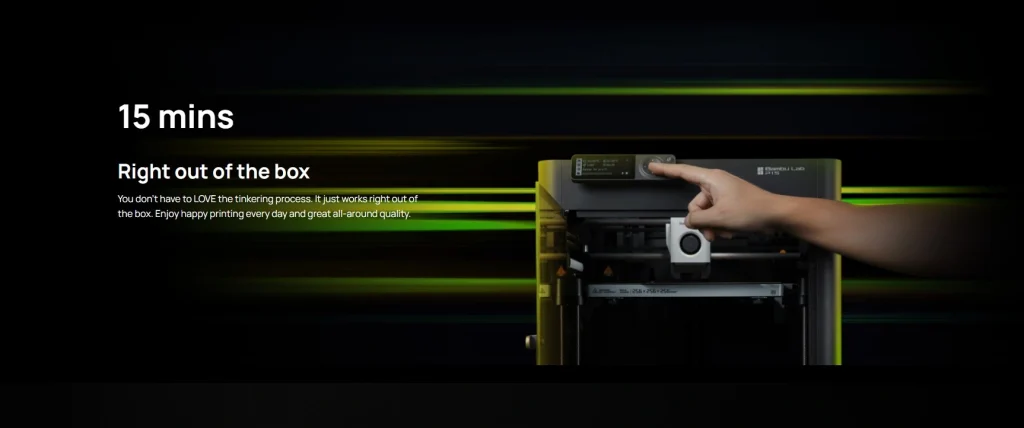
Multi-Colour Mastery with AMS
But wait – there’s one more trick up its sleeve for creative minds. Want to print a rainbow dragon or colour-coded engineering parts? The Bambu Lab P1S transforms into a creative powerhouse with Bambu Lab’s Automatic Material System (AMS). Clip on this add-on and unlock:
- Up to 16-colour printing – automatically
- Material mixing for smooth gradients and eye-popping effects
- Hands-free creativity: No more pausing prints to swap filaments manually
Quick note: The AMS is sold separately, but for makers who crave complex, multi-material designs? It’s less an accessory and more a superpower.
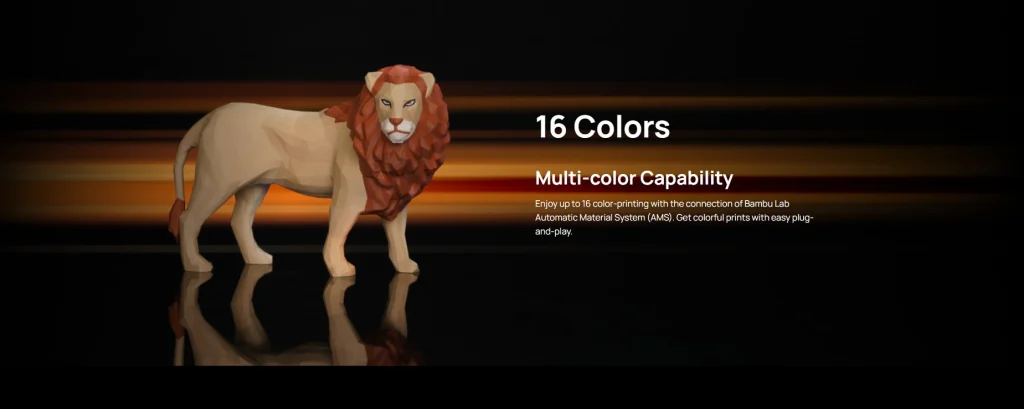
Precision Engineering: Quality at Any Velocity
But speed alone isn’t enough – and the Bambu Lab P1S knows it. Here’s where it outsmarts the competition: it stays sharply detailed even when sprinting like a cheetah. Two unsung heroes make this magic happen:
Automatic Bed Levelling (ABL):
No more bed-levelling rituals or the dreaded “paper slide test.” The P1S scans your bed like a GPS mapping terrain, nailing first-layer adhesion so perfectly it’s practically cheat-code level.
Vibration Compensation:
Think of this as noise-cancelling headphones for your prints. It predicts and zaps micro-wobbles before they happen. Curves flow like silk, corners stay razor-sharp, and layer lines? They practically disappear.
The payoff? Museum-quality prints without babysitting settings – even when you’re pushing 80% of max speed. This isn’t just precision; it’s Bambu Lab P1S making you look like a pro while you sip coffee.
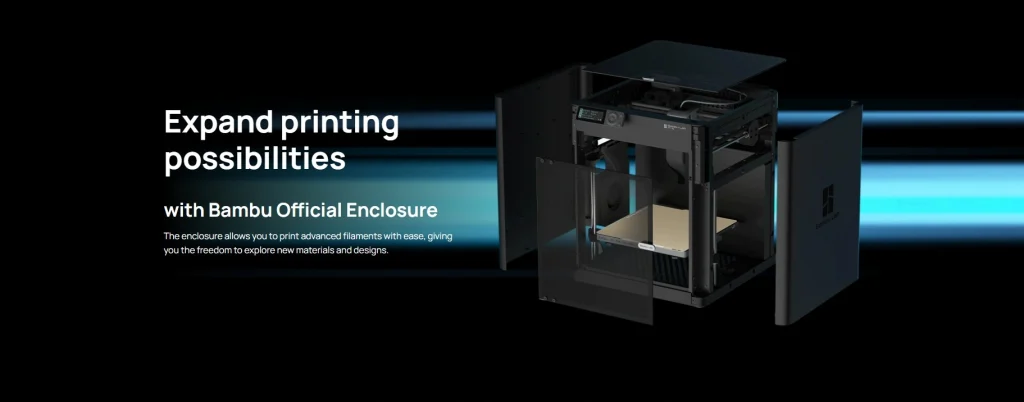
Enclosed Chamber: Unlock Advanced Materials
Now, imagine pairing that precision with a controlled environment. Remember the P1P’s open frame? Great for PLA, frustrating for ABS. The Bambu Lab P1S fixes that with a fully enclosed chamber that’s three things at once:
- A microclimate maestro: Traps heat to prevent warping in tricky materials like ABS, ASA, and Nylon
- A noise dampener: Quiets operation for classrooms or shared living spaces
- A safety shield: Keeps curious fingers (and pets) safely away from hot components
This isn’t just an upgrade – it’s a material freedom upgrade. Suddenly, engineering-grade parts become desktop-accessible.

Direct Drive Extruder: Command Over Filament
Inside that protected chamber, another hero quietly shines. Flexible filaments like TPU? Other printers choke. The Bambu Lab P1S thrives. Its direct drive extruder grips filament like a seasoned craftsman, giving you:
- Pixel-perfect retraction: Say goodbye to stringing on detailed miniatures
- Flexible material mastery: TPU bends without snapping, TPU+ prints without jamming
- Waste reduction: Fewer failed extrusions mean more filament for your actual creations
It’s the difference between wrestling with material and letting the machine handle the heavy lifting.
Software and user experience
Let’s talk software – because even the best printer feels like a brick without brains. The Bambu Lab P1S nails that “just works” magic from unboxing to final print. Here’s how it turns complex tech into pure convenience:
Out-of-Box Experience: Print Before Your Coffee Cools
No engineering degree required. Unbox the Bambu Lab P1S, plug it in, and let its auto-calibration handle the heavy lifting. We’re talking:
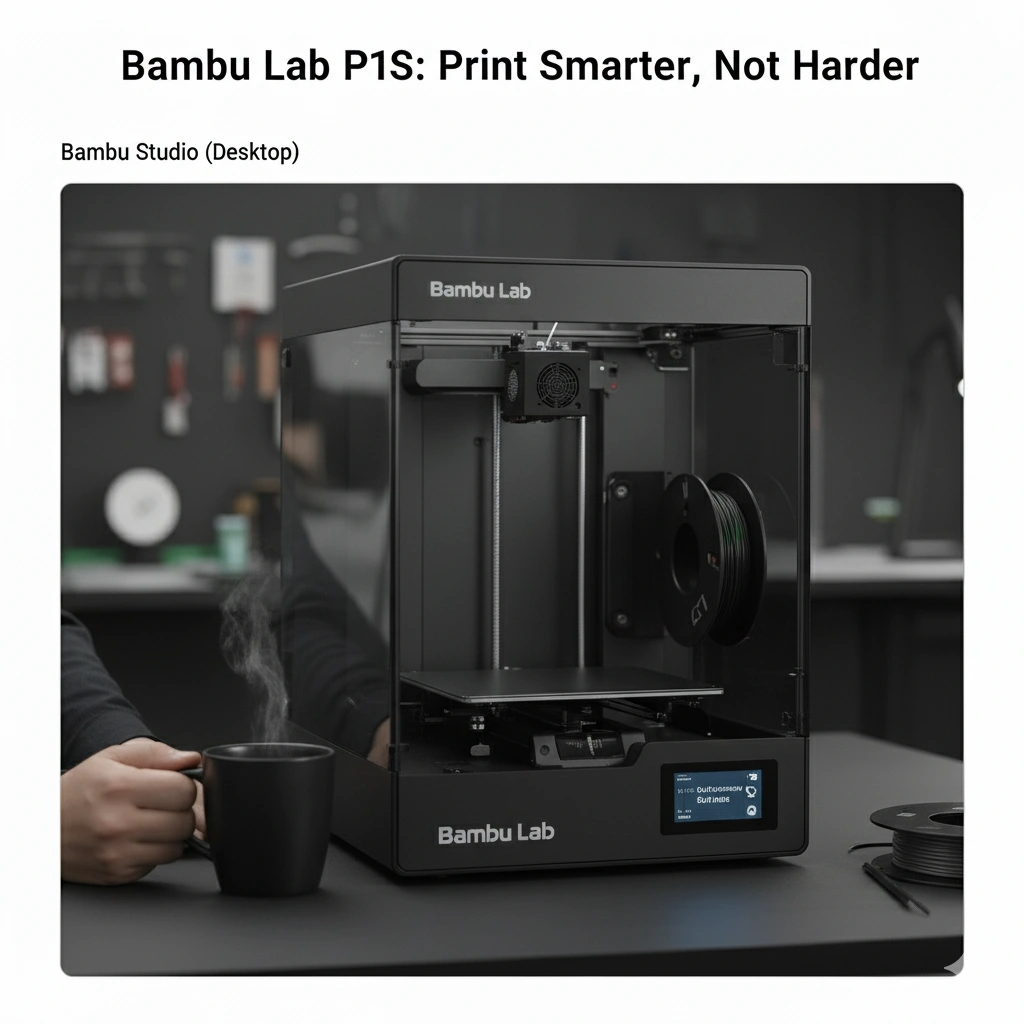
- Auto bed leveling? Done.
- Nozzle height checks? Sorted.
- Vibration tuning? Handled.
Real talk: You’ll be printing before you finish your first cup of setup coffee.
Software Suite: Brains & Brawn Working Together
But here’s where it gets clever:
- Bambu Studio (Desktop):
Think of it as your print’s personal trainer. It slices complex models at lightning speed, optimizes settings specifically for the P1S’s power, and even suggests material profiles. Bonus: It’s free and constantly evolving.
- Bambu Handy (Mobile App):
Your printer’s remote control. Start/stop prints, tweak temperatures, or check progress from your couch. Print going sideways? Get phone alerts before spaghetti monsters happen.
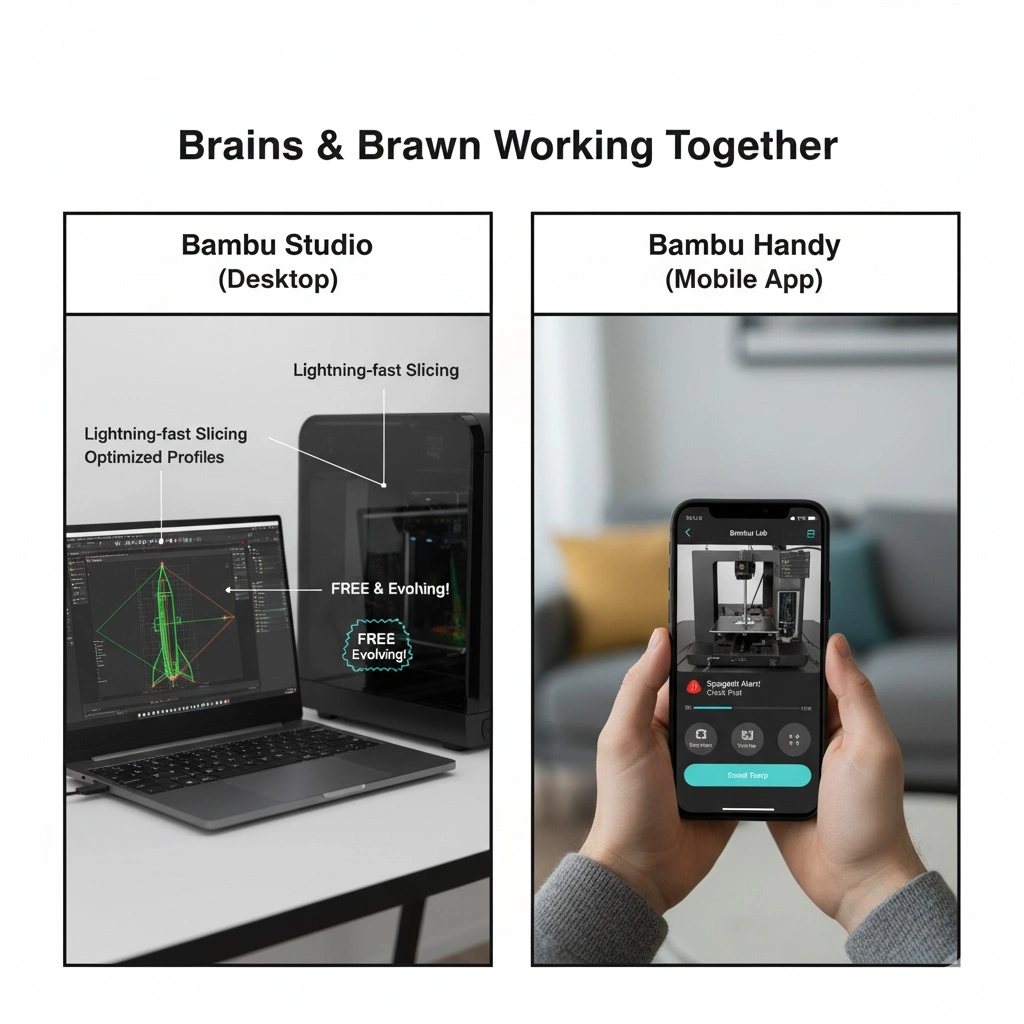
Remote Monitoring: Spy Cam Perks

And that built-in 720p camera? It’s not just for show.
- Live viewing: Peek at prints from anywhere (lifesaver for overnight jobs).
- Auto time-lapses: Turn your 8-hour print into a 30-second “wow” video.
- Peace of mind: See that first layer sticking perfectly while you’re at work.
Connectivity: Plays Nice With Your Network
Better yet:
- Wi-Fi/Bluetooth:
Seamless setup for most homes.
- “LAN Only” Mode:
Privacy warriors, rejoice. Go fully offline if cloud connections make you nervous (schools, labs, we see you).

User Interface: Simple by Smart Design
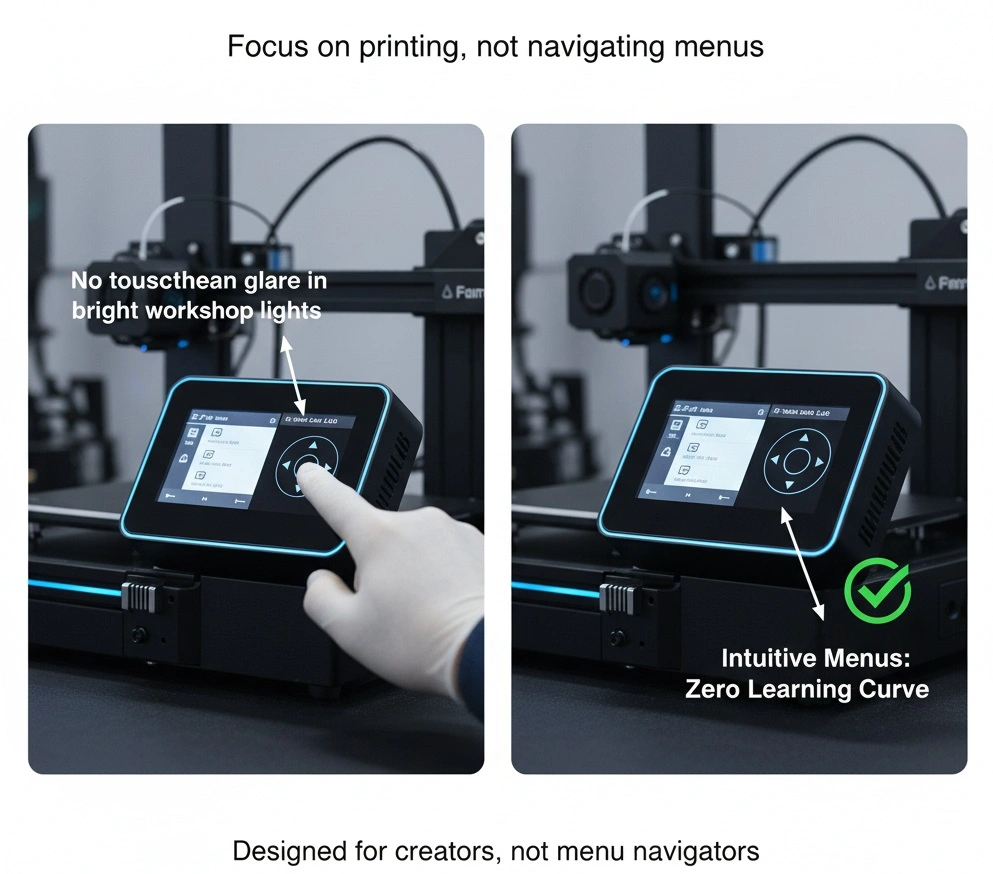
Finally, that 2.7-inch monochrome screen? Deliberately basic. Why? Because you’ll barely touch it. The directional pad and intuitive menus mean:
- No touchscreen glare in bright workshop lights
- Zero learning curve
- Focus on printing, not navigating menus
Supported materials and compatibility
The Bambu Lab P1S is basically a material buffet – it devours the good stuff:
✅ PLA/PETG (your everyday workhorses)
✅ Flexible TPU (bendy prints? Handles like a pro)
✅ ABS/ASA (engineering-grade toughness without warping meltdowns)
✅ Nylon & Polycarbonate (when you need parts that laugh at heat)
Meanwhile, the filament sensor? Total lifesaver. It pauses mid-print the second your spool runs dry, letting you swap materials without crying over a 12-hour print failure.
But here’s the fine print: Abrasive filaments like carbon fiber or glass-filled blends? They’ll grind down the standard hotend like sandpaper. For those heavy-duty jobs, you’ll need a hardened steel upgrade.
So what’s the verdict? For 95% of projects, this printer happily munches whatever you feed it. For that other 5%? A quick hotend swap unleashes the beast..
CoreXY up to 20000 mm/s² Acceleration
The P1 series inherits the proven kinematics and motion control system of the Bambu Lab Flagship printer. It prints with a top speed of 500 mm/s, the acceleration from zero to 500 mm/s takes just 0.025 seconds.
Vibration Compensation & Pressure Advance
The active vibration compensation (XY) algorithm and pressure advance guarantees extra smoothness and gets you good prints.
Considerations and potential downsides
Let’s be real – no printer’s flawless, and the Bambu Lab P1S has a few personality traits worth knowing upfront. None will make you regret buying it, but forewarned is forearmed:
🔊 First Up: It’s Got a Voice (And Opinions)
At full throttle? The Bambu Lab P1S roars. Fans kick into jet-engine mode, motors hum like a rock concert, and the enclosure turns it all into a mini amphitheater. Quick fixes that actually work:
- Park it on a heavy oak table (or concrete slab) with rubber vibration pads underneath – cuts the racket by half.
- Switch to “quiet mode” profiles at night (slower acceleration = less angry bee sounds).
- If possible? Give it its own corner or close the workshop door during marathon prints.
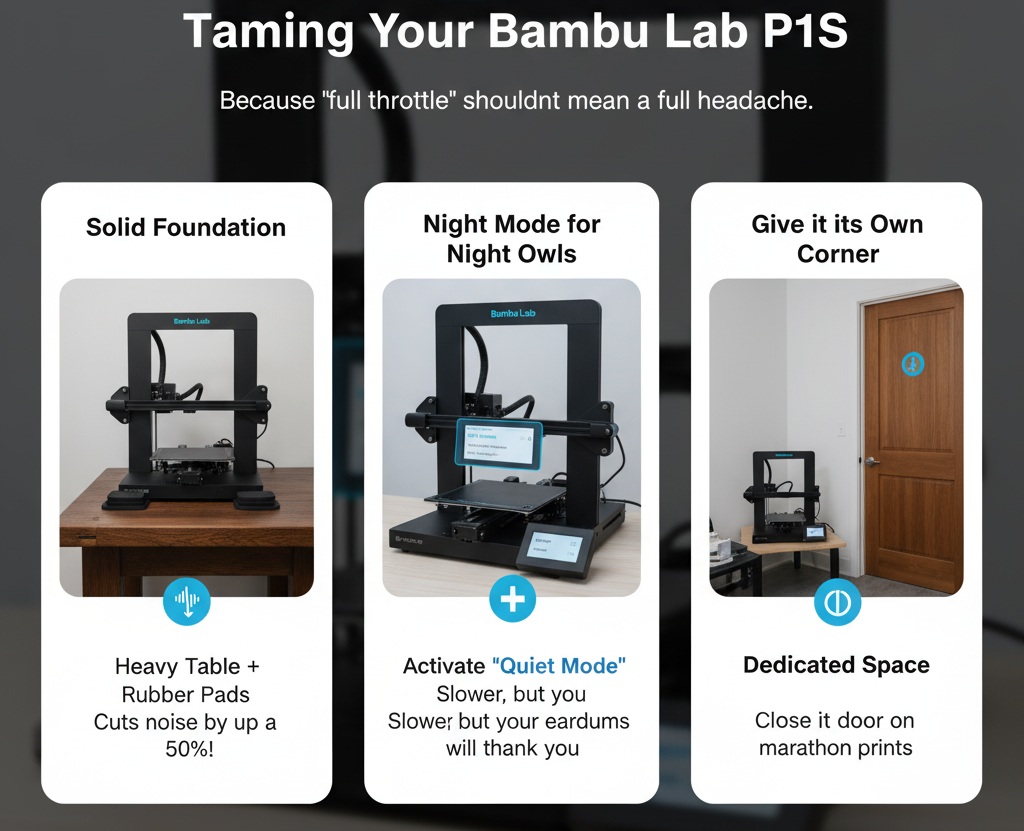
📱 Then There’s the Screen: Retro Vibes Only
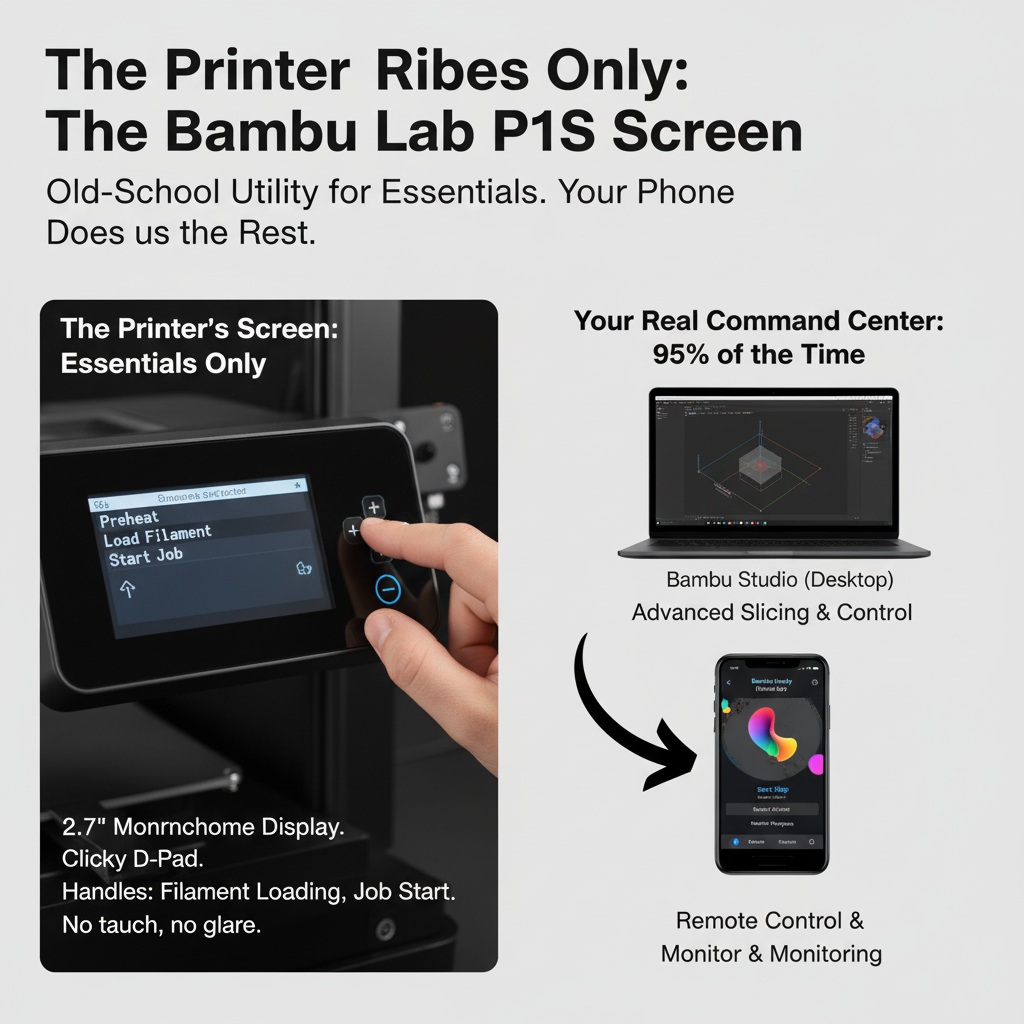
That tiny monochrome screen with the clicky D-pad? Pure old-school utility. It handles essentials (preheating, loading filament, starting jobs) like a champ, but don’t expect touchscreen magic or swipey menus. Realistically? You’ll live in Bambu Studio (desktop) or the Handy app (phone) for 95% of control. The screen’s just there for emergencies.
☁️ Cloud leaning: Connectivity on your terms
On connectivity, some conveniences—remote control from outside your network, push alerts, and cloud sharing—lean on Bambu Cloud. Prefer privacy? Switch to LAN‑only mode for local control and monitoring. You can also stick to local file transfers and keep the cloud switched off.n.

🏷️ And While We’re Talking Extras: The RFID Double-Edged Sword
Third-party filament? Works beautifully in the Bambu Lab P1S. But Bambu’s RFID-tagged spools? They’re like VIP passes:

- Tap-to-auto-detect material (no more “Is this PETG or ABS?” panic)
- Pre-tuned profiles that just work
- In the AMS? Some non-Bambu spools might need a $5 adapter or a quick rewind to fit.
Bottom Line: Small Trade-Offs for a Beast of a Printer
You’re trading a bit of noise, a basic screen, and some cloud conveniences for a Bambu Lab P1S that prints like a dream and handles advanced materials like a pro. If you value reliability over polish? These quirks are just tiny speed bumps on an otherwise smooth highway.
Comparison with other Bambu Lab printers
Bambu Lab Printer Comparison
| Feature | P1S | P1P | X1 Carbon |
|---|---|---|---|
| Enclosure | Fully enclosed | Open-frame (optional upgrade) | Fully enclosed |
| Cooling System | Improved cooling | Standard cooling | Advanced cooling |
| Activated Carbon Filter | Included | Optional | Included |
| Screen | Basic screen | Basic screen | High-resolution touchscreen |
| Calibration Technology | Standard calibration | Standard calibration | LIDAR-assisted calibration |
| Build Quality | Solid | Basic | Premium |
| Price | Mid-range | Budget-friendly | High-end |
Why the Bambu Lab P1S Belongs in Your Workshop
Let’s cut through the noise: The Bambu Lab P1S isn’t just another 3D printer – it’s that rare machine that actually lives up to the hype. It’s fast, reliable, and has that “just works” magic that makes you wonder why other printers make life so hard. Here’s why it’s worth every penny:
First Off: It Tames Advanced Materials Like a Pro
That fully enclosed chamber? It’s a game-changer. Open-frame printers turn ABS and ASA into warped potato chips, but the P1S locks in heat like a seasoned chef. Suddenly:
- Engineering-grade parts come out straight
- Your workshop doesn’t smell like a chemical plant (thanks to that carbon filter)
- Noise stays at “pleasant hum” instead of “jet engine taking off”
- Translation? Materials that used to give you nightmares become your new favorites.
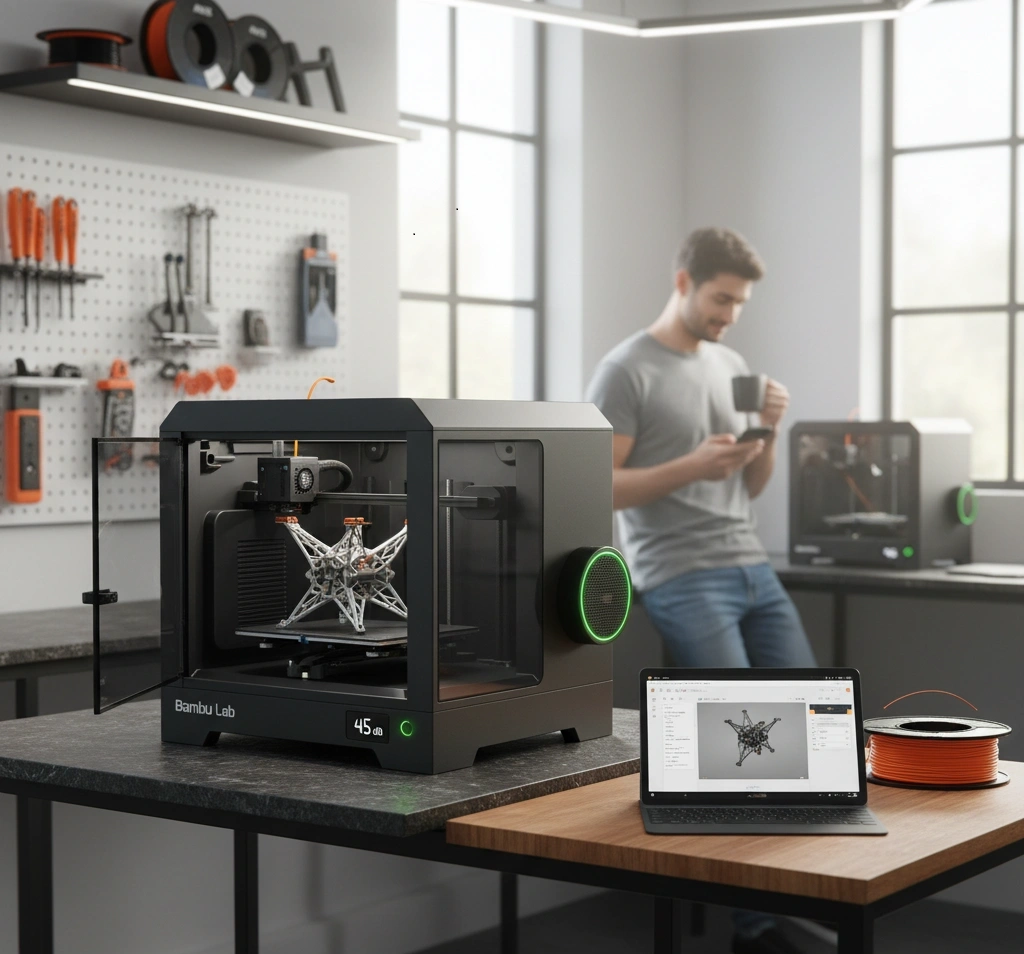
Then There’s the Speed: It Prints Like It’s Late for a Meeting

500 mm/s isn’t just a spec – it’s your new reality. The P1S churns out prototypes so fast you’ll rethink project timelines. But here’s the kicker: it doesn’t sacrifice quality. Even at full sprint, details stay crisp, curves stay smooth, and layer lines practically vanish. Real talk: It’s the printer that makes you look like a wizard while you’re actually just sipping coffee.
Setup? So Easy It Feels Like Cheating
Unbox the P1S, plug it in, and its auto-calibration handles the heavy lifting. We’re talking bed leveling, vibration tuning, nozzle checks – all done while you grab a snack. Fifteen minutes later? You’re printing. No PhD required, no YouTube tutorials, just pure “I can’t believe it was this easy” satisfaction.
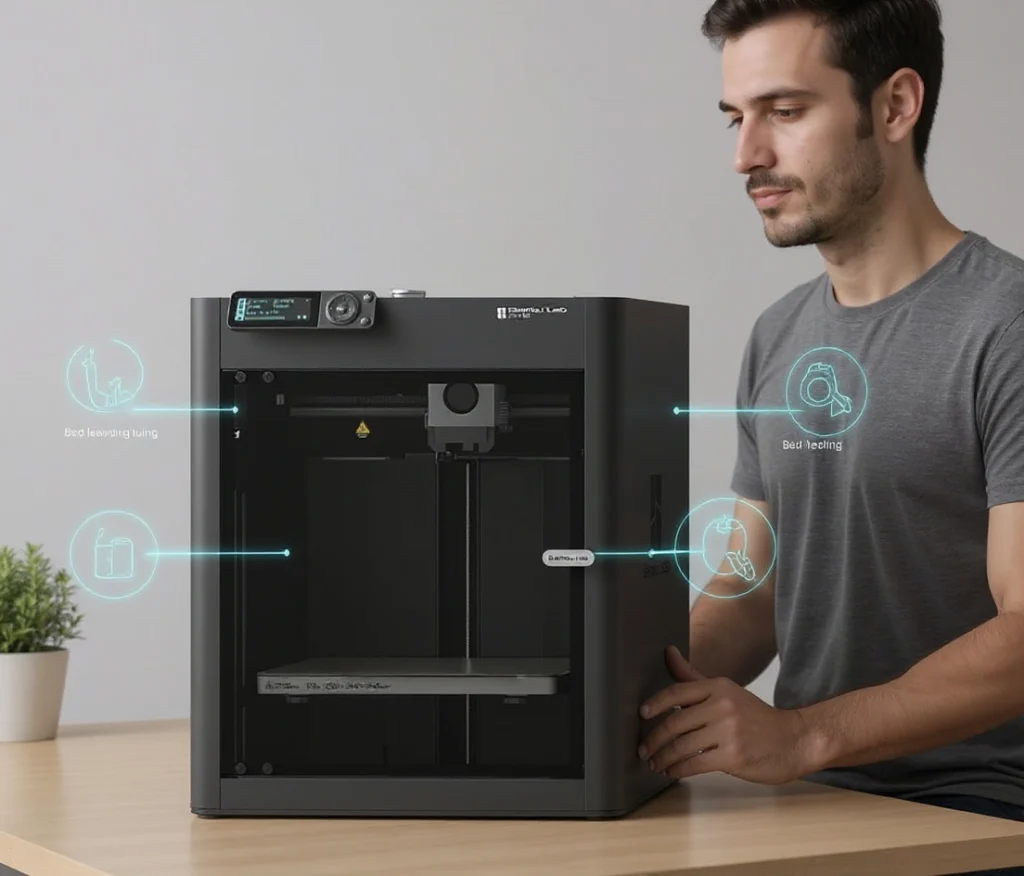
And When You’re Feeling Creative? It Becomes an Art Studio
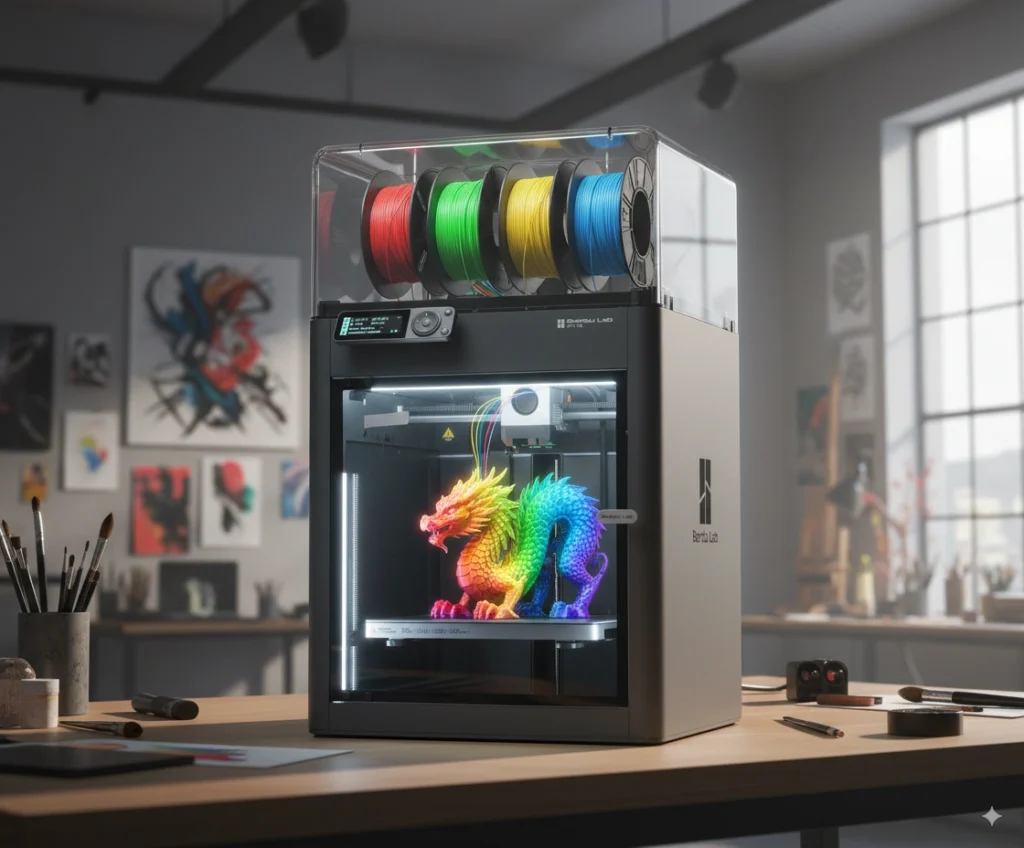
Clip on Bambu’s AMS (Automatic Material System), and suddenly the P1S transforms. Print rainbow dragons, color-coded prototypes, or multi-material parts – up to 16 colors without babysitting spool swaps. It’s the kind of flexibility that turns “I wish I could” into “Look what I made.”
Finally: The Software That Actually Gets You
Bambu Studio slices files like a dream, and the mobile app lets you monitor prints from your couch (or bed, or coffee shop). That built-in camera? It’s not just for show – catch issues before they become disasters, or turn an 8-hour print into a 30-second time-lapse that blows up your Instagram. Bottom line: The ecosystem makes the printer feel like an extension of your brain.
FAQ
What’s the difference between P1S and P1P?
The P1S offers several key upgrades over the P1P. The P1S features a fully enclosed printing chamber with glass panels and doors, while the P1P has an open frame design. The P1S includes a more powerful cooling solution with three additional fans:
- Auxiliary Part Cooling Fan for cooling prints
- Chamber Regulator Fan to stabilize internal temperature
- Control Board Fan for cooling electronics
The P1S also comes with an activated carbon filter to reduce odors and harmful gases when printing materials like ABS. Additionally, the P1S uses an enhanced toolhead cable with a cable chain for improved durability.
What materials can the P1S print?
The P1S handles a wide range of filaments effectively:
| Material Category | Performance |
|---|---|
| PLA, PETG, TPU, PVA, PET | Ideal |
| ABS, ASA | Ideal (thanks to enclosure) |
| PA (Nylon), PC | Capable |
For fiber-reinforced filaments like carbon fiber or glass fiber, you’ll need to upgrade to a hardened steel nozzle and extruder gear assembly first. The standard setup is not recommended for these abrasive materials.
Can I control the chamber temperature?
No, the P1S does not have precise chamber temperature control. The chamber temperature increases based on the heated bed temperature settings, but cannot be directly controlled or set to a specific value.
What regular maintenance does the P1S require?
Routine maintenance for the P1S is relatively minor. It involves occasionally greasing the lead screws (every three months) and wiping down the carbon rods with a lint-free cloth and isopropyl alcohol (monthly). The Y and Z linear rods should also be cleaned and lubricated monthly. It’s also good practice to periodically clean the cooling fans and the nozzle.
How often do parts like the nozzle and PTFE tubes need to be replaced?
The nozzle is a consumable part, and its lifespan will depend on the types of filament used. It’s recommended to inspect and clean the nozzle, especially after using abrasive filaments. The PTFE tubes that guide the filament can also wear over time and may need to be replaced if they cause friction or clogs.
